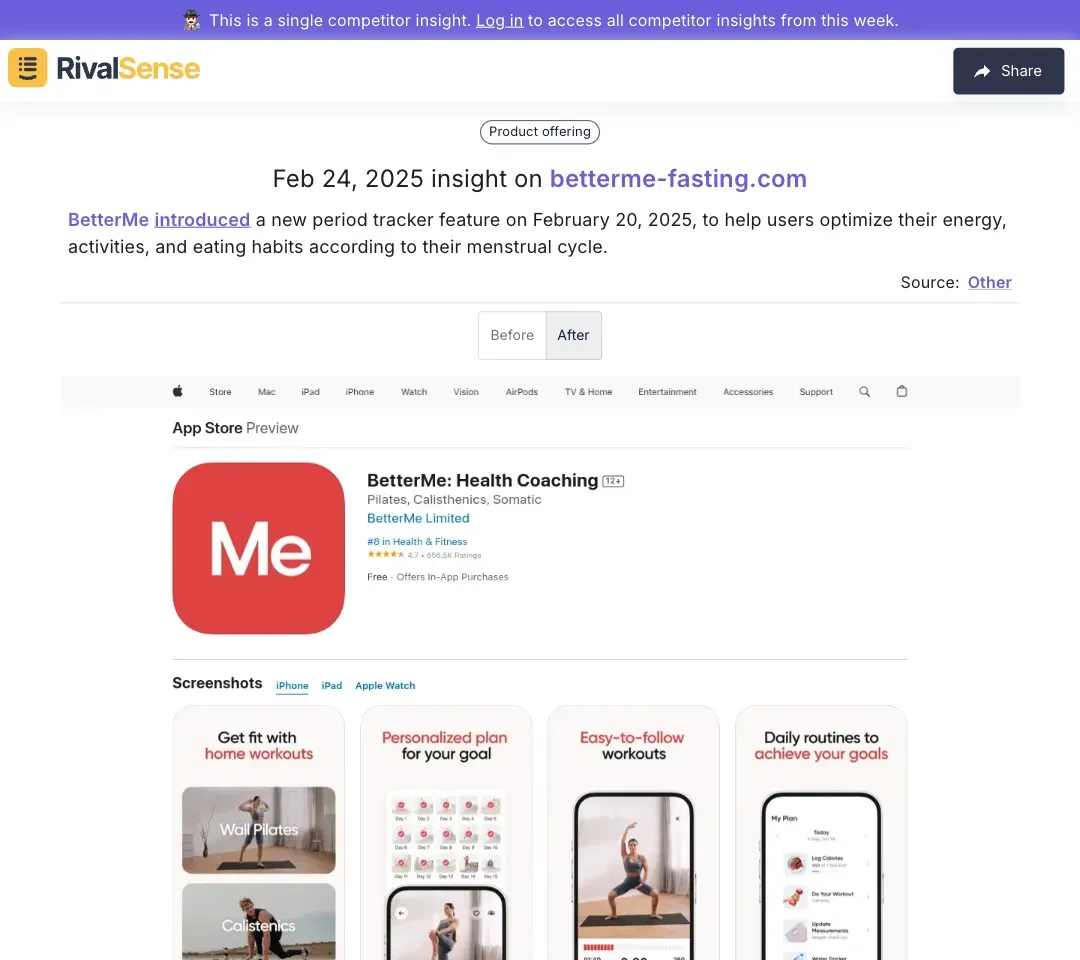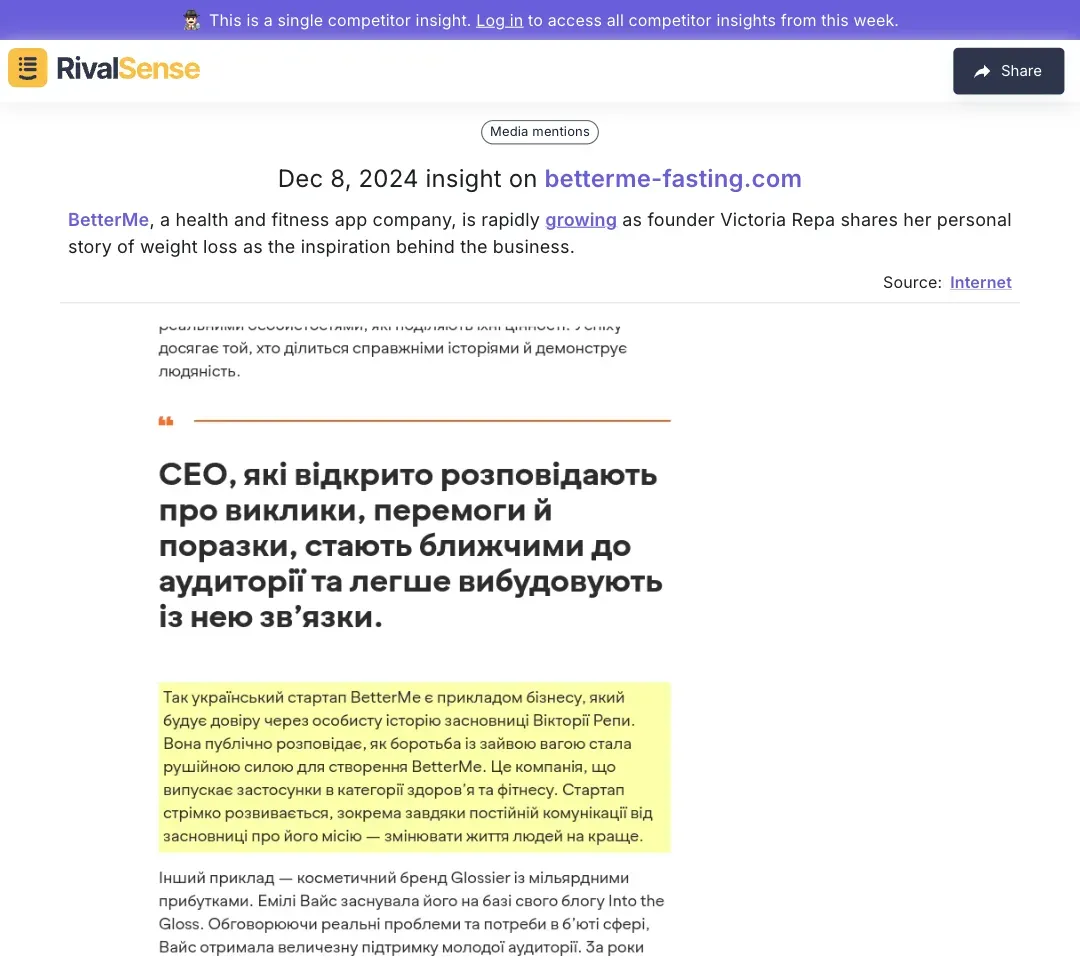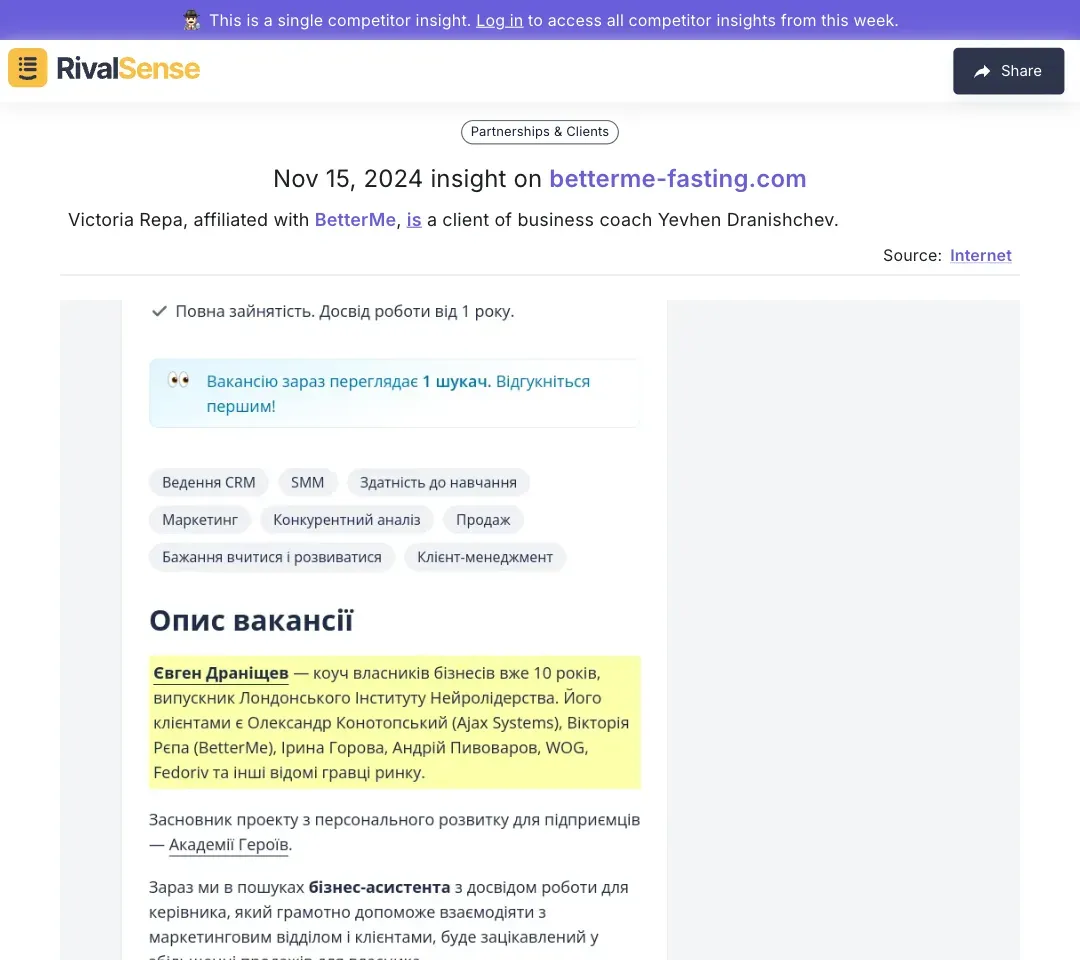How BetterMe Dominated the Health App Market Using Competitor Intelligence
In the bustling health app market, BetterMe has emerged as a standout success, thanks to its rapid growth and strategic market positioning. Founded by Victoria Repa, whose personal journey toward health and wellness inspired the brand, BetterMe resonates deeply with users seeking transformative solutions. This case study reveals how competitor intelligence fueled their rise—proving that understanding rivals isn't just reactive monitoring, but proactive strategy. For founders and CEOs, BetterMe's playbook offers actionable frameworks to turn market insights into competitive advantages.
Here's how to harness competitor intelligence effectively:
- Identify Key Competitors: Map direct/indirect players in your niche.
- Analyze Offerings: Study features, pricing, and user feedback for gaps.
- Monitor Marketing: Track campaigns, messaging, and engagement tactics.
- Learn from Failures: Analyze competitor missteps to avoid pitfalls.
- Innovate Strategically: Use insights to differentiate your value proposition.
Innovative Feature Development: The Period Tracker Example
BetterMe identified a critical market gap: most period trackers lacked integration with fitness/nutrition guidance. By analyzing competitor offerings and user feedback, they realized users wanted holistic cycle-based health optimization. This led to a feature combining menstrual tracking with personalized energy, activity, and diet recommendations—addressing unmet needs competitors overlooked.
RivalSense Insight: Tracking feature launches like BetterMe's period tracker (February 2025) reveals how competitors evolve. This intelligence helps you spot innovation patterns and anticipate market shifts.

BetterMe's feature helps users optimize habits based on menstrual cycles—a response to competitor gaps.
Actionable Framework:
✅ Gather User Feedback: Conduct surveys/interviews to uncover pain points.
✅ Audit Competitors: Document feature weaknesses in rival products.
✅ Prototype & Test: Build MVPs and iterate based on early feedback.
✅ Measure Impact: Track engagement metrics post-launch (e.g., BetterMe's 30% retention boost).
Founder's Vision and Personal Branding as a Growth Lever
Victoria Repa’s weight-loss journey isn't just backstory—it’s BetterMe’s emotional core. Her authentic storytelling built trust and community, turning users into advocates. In crowded markets, founder narratives humanize brands and create differentiation competitors can't replicate easily.
RivalSense Insight: Monitoring founder activities—like Repa sharing her origin story—uncovers branding strategies that drive loyalty. This helps you benchmark emotional positioning in your industry.

Repa's personal narrative fuels BetterMe's mission—showcasing how authenticity attracts users.
Practical Brand-Building Steps:
🔹 Audit Your Narrative: Align your story with company values (e.g., Repa's fitness struggles → BetterMe's solutions).
🔹 Engage Relentlessly: Share journeys on LinkedIn/Instagram to build connections.
🔹 Amplify User Stories: Feature customer transformations to reinforce community trust.
Strategic Partnerships and Mentorship in Scaling a Business
BetterMe accelerated growth through expert guidance, notably from business coach Yevhen Dranishchev. Mentorship provided strategic clarity during scaling, while partnerships with fitness influencers amplified reach. Such relationships offer shortcuts through proven frameworks and expanded networks.
RivalSense Insight: Discovering connections like Repa-Dranishchev reveals hidden growth levers. Tracking management relationships helps identify industry mentors or potential partners.

Repa's mentorship under Dranishchev highlights how expert guidance shapes strategy.
Execution Checklist:
- [ ] Seek Specialized Mentors: Choose advisors with domain-specific expertise.
- [ ] Define Partnership Criteria: Collaborate only with brands sharing your values.
- [ ] Set Quarterly Goals: Work with mentors to break down objectives (e.g., user acquisition targets).
Competitor Insights: A Blueprint for Market Success
BetterMe dominated by systematically analyzing rivals—tracking features, pricing, and reviews to spot opportunities. Their approach balances adopting best practices (like intuitive UX) while innovating uniquely (e.g., AI-driven personalization). This dual focus avoids imitation and builds defensible moats.
Actionable Framework:
| Step | BetterMe’s Tactic | Your Move |
|---|---|---|
| Audit Competitors | Mapped top 5 health apps | Use tools like RivalSense for automated tracking |
| Identify Gaps | Noted poor cycle-fitness integration | Analyze app store reviews for recurring complaints |
| Test Solutions | Piloted period tracker MVP | Launch beta features to niche user groups |
| Iterate | Refined based on engagement data | Blend competitor insights with original R&D |
Conclusion: Turn Insights Into Action
BetterMe’s success underscores that competitor intelligence is non-negotiable for market leadership. Their strategy—continuous monitoring, gap-driven innovation, and authentic branding—can be replicated in any B2B context. Start by auditing rivals monthly, prioritizing customer feedback, and automating insight collection.
🚀 Ready to decimate your competition? Try RivalSense free today. Get your first competitor report delivered instantly—no "waiting periods." Track product launches, pricing shifts, and leadership moves while you focus on out-innovating rivals.
📚 Read more
👉 5 Actionable Strategies to Leverage Competitor Insights from Events
👉 Navigating Tariff Uncertainty: How Competitive Intelligence Becomes Your Strategic Compass
👉 Decoding Executive Moves: How Stephen Kruger's Transition Impacts Competitive Landscapes
👉 How Trend Micro's Android Botnet Research Reveals Critical Competitive Shifts
👉 Practical Competitive Intelligence for Leadership: A Step-by-Step Guide
